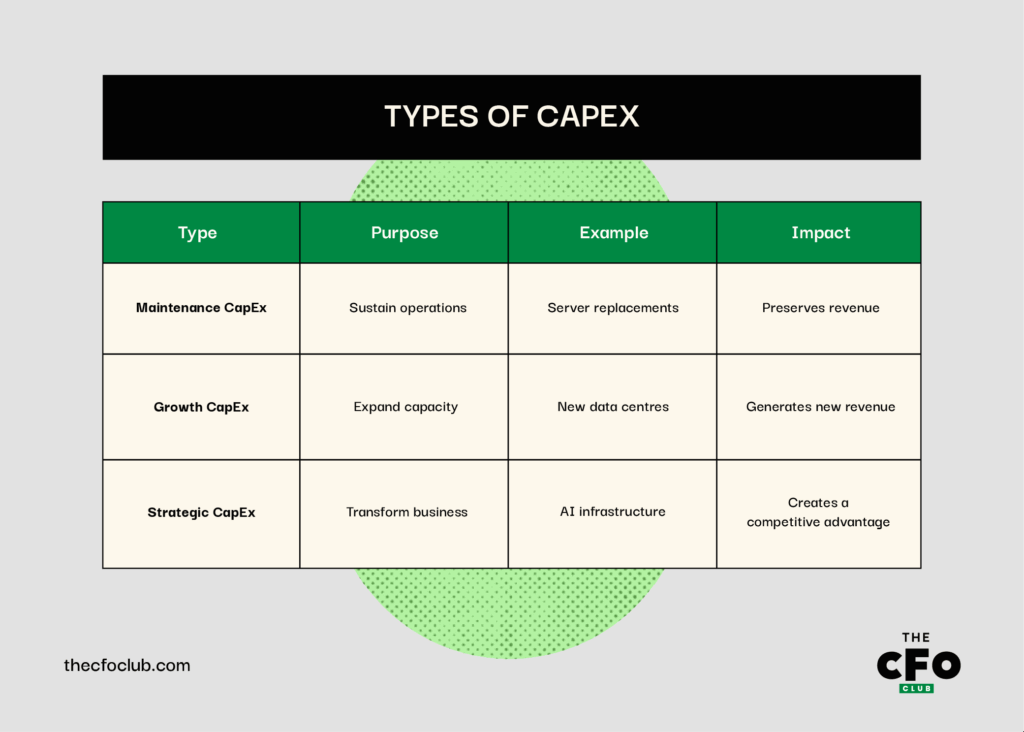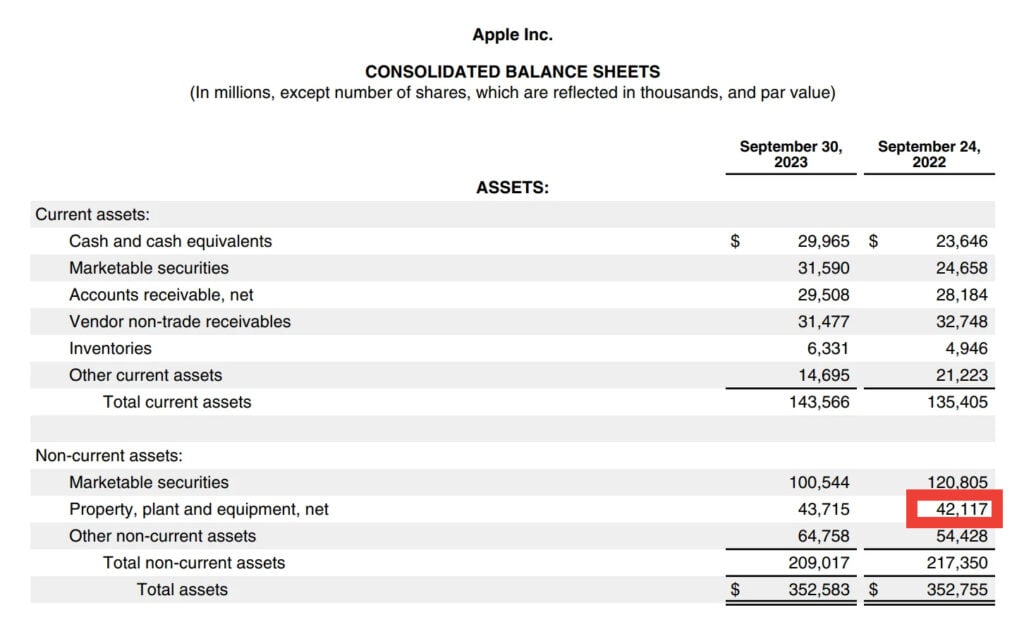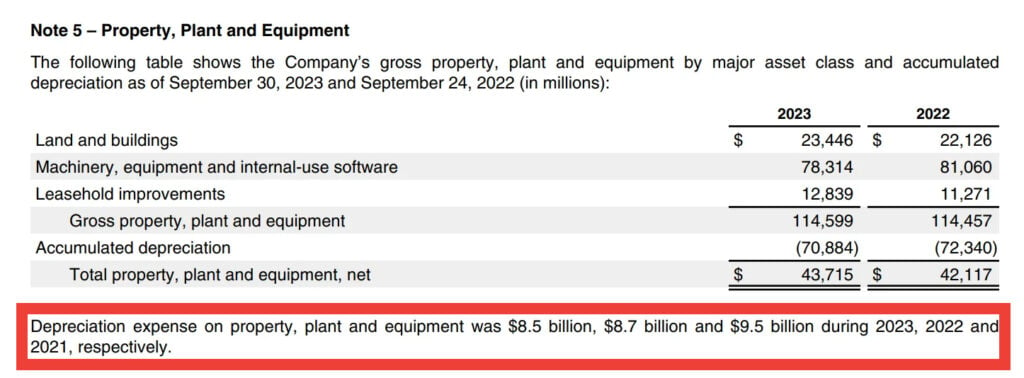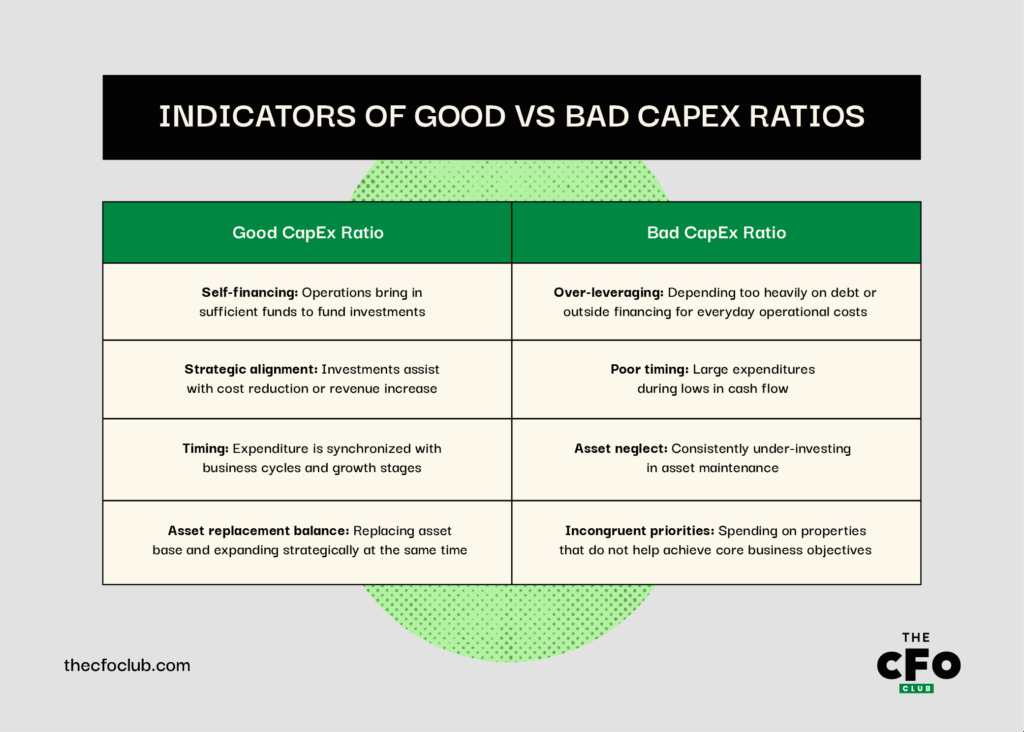CapEx Formula, Decoded: The CapEx formula consists of three metrics: ending PP&E, beginning PP&E, and depreciation.
Future Foresight: For CFOs, the CapEx formula offers a clear snapshot of capital investment over time. It helps assess how effectively your organization is reinvesting in long-term assets to support strategic growth.
Mistakes = Less Growth: CapEx mistakes—particularly confusing OpEx with CapEx—can be costly. CFOs should rely on strong financial planning software to ensure accurate classification and long-term forecasting.
Understanding the CapEx formula isn’t about the math—it’s about the mindset. It shows things like where the business is placing its bets, how agile its infrastructure really is, and whether the current investments align with future value creation.
As a digital software expert who partners closely with CFOs and FP&A leaders across industries, I’ve noticed a common thread: while most finance teams have the formula down cold, the real differentiator lies in how they interpret it to shape capital allocation, long-term strategy, and operational resilience.
In this guide, I deep dive into how the CapEx formula unlocks insights about asset intensity, reinvestment cadence, and capital prioritization. I’ll also show how digital tools can help surface these patterns faster, giving you not just visibility, but foresight.
What Is Capital Expenditure?
Capital expenditure, also known as capital expenses, refers to money spent on purchasing, improving, and maintaining long-term physical assets collectively known as property, plant, and equipment (PP&E). They help businesses grow, stay competitive, and plan long-term finances.
Some common examples of CapEx include:
- Machinery
- Vehicles
- Buildings/office spaces
- Servers
- Computers/hardware
- Construction equipment
CapEx is typically recorded on a company’s cash flow statements under investing activities, while PP&E appears on balance sheets as an asset. It can be calculated using the following formula:

Types of Capital Expenditure
Capital expenditure is split into three types based on your reason for spending: maintenance, growth, and strategy. Here’s a quick overview:

1. Maintenance CapEx
Maintenance CapEx is any expense related to the repair or upgrade of existing physical assets. Its purpose is to maintain your current operational capacity with conservative spending.
Some examples of Maintenance CapEx for CFOs include:
- Extend the useful life of critical assets, ensuring consistent output without costly unplanned downtime.
- Maintain compliance and safety standards, reducing exposure to regulatory risk and operational liabilities.
- Uphold customer experience and brand trust by minimizing disruptions tied to aging systems or degraded performance.
Say you manage finance at a manufacturing firm and need to speed up production with a limited budget. An example of capital expenditure dedicated to maintenance could be fixing existing machines instead of replacing them.
In the long run, a well-executed Maintenance CapEx helps reduce total cost of ownership, improve asset efficiency, and protect liquidity.
2. Growth CapEx
Growth CapEx includes long-term investments that fuel business expansion. It increases capacity and prioritizes new products and services.
Think expanding a logistics network to support omnichannel growth, investing in a new data center to scale infrastructure, or acquiring real estate in a high-growth region. These are deliberate decisions to build for tomorrow, not just support today.
As a CFO, you might use Growth CapEx to:
- Expand production capabilities to meet rising demand while maintaining cost-efficiency and margin discipline.
- Enter new markets or geographies by investing in distribution networks, localized infrastructure, or regulatory-readiness.
- Support product line extensions with targeted investments in R&D facilities, specialized equipment, or dedicated go-to-market capacity.
Take Target, for example. The business earmarked $5 billion to open approximately 30 new stores in 2022—that’s Growth CapEx at its finest.
3. Strategic CapEx
Strategic CapEx positions companies ahead of the curve, focusing on forward-looking actions like redefining company models for long-term value. It enhances your competitive position or helps improve operations.
Today’s most effective finance leaders use CapEx as a lever to:
- Build AI/ML infrastructure to support data-driven products, predictive operations, and intelligent automation.
- Deploy advanced automation systems that eliminate inefficiencies and compress operating cycles.
- Enable digital-first business models that position the company for new revenue streams or go-to-market strategies.
Let’s consider Microsoft. In a bid to keep up with increased interest in artificial intelligence worldwide, the tech giant budgeted $80 billion to develop AI-focused data centres.
CapEx Formula Calculator
Crunching numbers manually may be okay for small amounts and companies, but for larger businesses, automation is a game-changer. Simplify and speed up your capital expenditure calculation with our free CapEx formula calculator:
How To Use The CapEx Formula
Some CFOs like the quick solution, while others like to get into the numbers manually. If you’re the latter, here’s what you’ll need to calculate your capital expenditures:
- Ending PP&E: Current period's closing Property, Plant & Equipment balance
- Beginning PP&E: Prior period's closing PP&E balance
- Depreciation: Recognized depreciation expense during the period
And this is where you can find them:
1. Find The Ending PP&E
You can find the ending PP&E line item under the non-current assets on your most recent balance sheet or the latest balance sheet for the period you’re reporting. It’s usually marked as “Property, Plan, and Equipment”, “Fixed Assets”, or “Net PP&E”.
Your ending PP&E reflects the total value of your capital assets (or long-term assets) used in operations at the end of the period. It’s often reported as net of accumulated depreciation, meaning the balance shown reflects the remaining useful value of the assets, not their original cost.
2. Find The Beginning PP&E
The beginning PP&E is usually recorded right beside the ending PP&E on your current balance sheet, so you don’t have to look too far. This amount represents the book value of all long-term physical assets that were in place and operational at the close of the previous accounting period.
Its value carries forward to serve as the opening balance in the current period’s fixed asset account.
3. Locate The Depreciation Amount
Depreciation is a non-cash expense noted on your income statement or your cash flow statement. It’s designed to spread out the life of your fixed assets and align costs with revenue generated.
4. Use The Calculation
Once you have the ending PP&E, beginning PP&E, and depreciation, put them into the CapEx formula to determine your capital expenditure.

Real-World Example of CapEx
Looking for a real-world example? Here’s how Apple reported their CapEx for 2023 using this exact method.
Apple (2023)
On the consolidated balance sheet in Apple’s 2023 Form 10-K, its ending PP&E is $43,715 million.

The tech giant’s balance sheet also shows a beginning PP&E of $42,117 million (for fiscal year 2022).

And, according to its PP&E note, depreciation was $8.5 billion (or $8,500 million).

Using the CapEx formula calculation, Apple’s 2023 CapEx should be $10,098 million.
($43,715M - $42,117M) + $8.5B = $10,098M
Note: Apple’s actual/reported CapEx for 2023 was $10,959M (as shared earlier). So why the $861M difference when we used the formula? Well, because unless you own or work at a company and have access to their exact numbers, discrepancies can arise from asset disposals, currency adjustments, or business acquisitions you aren’t privy to.
Good vs. Bad CapEx Ratios
The CapEx ratio measures how well a business’s operating cash flow can cover capital expenditures. It’s a great measure of financial health and investment sustainability. Typically, this is the common methodology used when determining the value of a company’s CapEx ratio:
- A strong CapEx ratio (>2) shows that your business operations generate enough cash to fund investments and more.
- A healthy CapEx ratio (1-2) indicates sustainable funding with some buffer.
- A low CapEx ratio (<1) suggests you’re relying on debt or external funding for CapEx.
To find your CapEx ratio, you simply need to divide your CapEx amount by your Operating Cash Flow amount.
For Example:
Say you work for a software development company. Your operating cash flow is $10 million and you’re spending $4 million on CapEx. With this formula, your CapEx ratio would be 2.5, meaning your company can comfortably fund its investments and still have cash left for other needs.
On the opposite end of the spectrum, pretend instead you work at an accounting firm that has an operating cash flow of $3 million and up to $5 million in CapEx. This firm’s CapEx ratio would be 0.6, signalling that the business may be overextending itself or too reliant on financing to maintain or grow operations.
Here are a few things that can impact this ratio:
- CapEx to Depreciation Ratio: Shows whether you are investing enough to maintain or grow your asset base. Anything less than 1 implies underinvestment or asset depletion.
- CapEx to Sales Ratio: Reflects how much of your sales revenue is being reinvested into capital assets. Anything under 5% reflects an asset-light business model or potential underinvestment.
But not everyone has the time to manage calculations. Some common day-to-day indicators of good and bad CapEx ratio can include:

When to Calculate CapEx
Many firms assess capital expenditures annually, typically when preparing their year-end financial reports. And while yearly CapEx reviews have their place, they can cause you to miss time-sensitive opportunities and misallocate capital.
So, beyond the mandatory end-of-year reporting, here are some other great times to calculate CapEx (depending on various business factors):
- At Budget Cycles: To align capital investments with business goals and ensure optimal financial modelling and planning.
- During Major Investments: To gauge affordability and potential impact before committing resources.
- Quarterly Financial Reports. To track capital spending trends and improve cash flow analysis and forecasting throughout the year.
- After Significant Business Model Changes: To reevaluate asset needs, monitor new investments, and adjust depreciation planning.
Top Mistakes Made When Calculating CapEx
CapEx is a key financial metric, and making a mistake when calculating it can ruin your entire strategy. Say you underestimate or overestimate expenses—you’ll be left with distorted profit margins, investment decisions based on the wrong numbers, and inaccurately filed tax returns.
The good news? Most CapEx calculation errors follow recognizable patterns. Here’s the most common mistakes and how you can avoid them:
Mixing Up CapEx vs. OpEx
The most common mistake most finance professionals make with capital expenditure assessments is confusing Operating Expenses (OpEx) with Capital Expenditures (CapEx).
This mixup may seem harmless on the surface, but it’s really not. It can actually shrink your EBITDA significantly, creating misleading ripple effects across financial statements and tax obligations.
Avoid this by noting the key differences between CapEx and OpEx:
- Capital Expenditure (CapEx) is about investing in fixed assets expected to bring long-term economic benefits. For example, repairing a roof, investing in cloud infrastructure, or buying new equipment for the business.
- Operating Expenses (OpEx): During the day-to-day running of a business, indirect expenses often come up that do not necessarily provide long-term return on investments. When these costs are incurred, they are called operating expenditures or expenses. They are also short-term and budgeted for instead of allocating large outflows of cash periodically. For example, rent, inventory costs, payroll, or marketing spend are operating expenses.
| Financial Component | CapEx Impact | OpEx Impact |
| Balance Sheet | Increases assets | No direct impact |
| Income Statement | Affected by depreciation over the years | Reduces profit immediately |
| Cash Flow Statement | Shows under investing activities | Shows under operating activities |
| Tax Implications | Deducted gradually through depreciation | Fully deductible in the current period |
Not Using Software
Manually computing capital expenditure (CapEx) adds needless risk. For example, simple Excel spreadsheets will likely fail when tracking multi-million-dollar capital investments.
Depreciation can get misstated, and formula mistakes could go unnoticed for months. When someone finally catches on, it may be too late to rectify. Enter CapEx software, which is especially important when dealing with complexities like:
- Multiple asset classes with different depreciation schedules
- Intercompany transfers on the Balance Sheet
- Capital projects across multiple reporting periods
- Acquisitions requiring PP&E reconciliation
Looking for the right CapEx software solution? Here are a few of my top recommendations:
Additional Financial Planning Resources
Looking for more insight into streamlining your financial planning process? Enhance your operations and workflow with these extra resources:
- The best corporate performance management software
- Corporate finance books with insights on solving complex challenges
- FP&A certification courses to build your financial reporting skills
- Corporate finance books to give you more insight and tips for handling complex fiscal challenges
Subscribe for More CapEx & Financial Insights
Want more strategic finance tips and practical tools? Subscribe to The CFO Club newsletter for expert advice from finance leaders in top firms.


![[Option 2] IMG CFO – How To Guide – capex formula – Oyinkansola Edem](https://thecfoclub.com/wp-content/uploads/sites/12/2025/07/Option-2-IMG-CFO-–-How-To-Guide-–-capex-formula-Oyinkansola-Edem-792x446.jpg)
